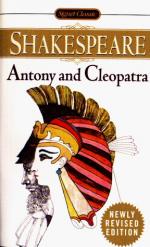|
This section contains 9,179 words (approx. 31 pages at 300 words per page) |

|
SOURCE: Fawkner, H. W. “Presence and Oblivion.” In Shakespeare's Hyperontology: Antony and Cleopatra, pp. 23-45. Cranbury, N. J.: Associated University Presses, 1990.
In the following excerpt, Fawkner examines the oppositional pattern of “following and leaving” in Antony and Cleopatra, which he suggests defines the conceptual structure of the drama.
At the most intense and fascinating level of dramatic suggestion, Shakespearean tragedy opens signification that is hyperontological. Shakespeare's language does not only dramatize certain human events, it also dramatizes the elusive play of certain logical fantasies, certain hyperlogical mystifications. These patternings, related as they are to what is philosophical in all human inquiry, are not external to the dramatic action—as “poetry” or “imagery” adorning it. Rather, these patternings are conceptual and hyperconceptual constructs that cause the organization of tragic discourse and the organization of tragic reality to become a unified sense of dramatic power.
While it is possible to...
|
This section contains 9,179 words (approx. 31 pages at 300 words per page) |

|


